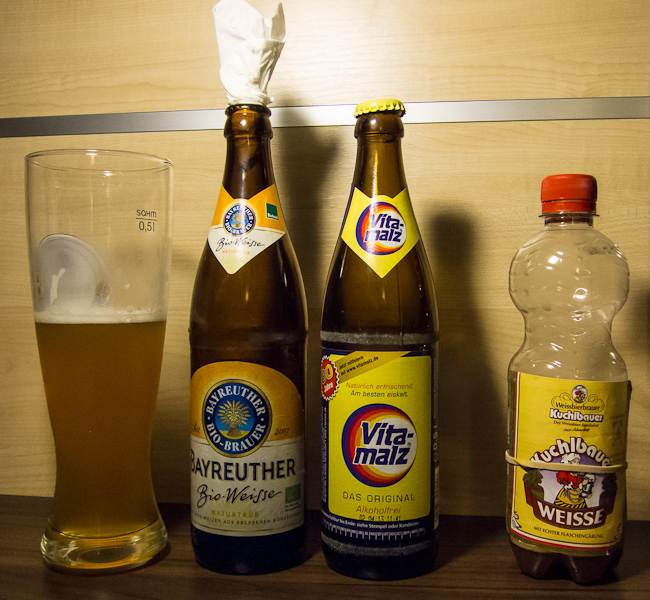A few years back I started bringing back the sediment from Weissbier bottles from trips to Germany in hope of finding live yeast. Unfortunately most of the Weissbier these days doesn’t rely on yeast for its cloudiness (protein haze does a much better job) and when yeast is added it is often dead. But a few breweries still do bottle fermentation (Flashengärung). Initially I ended up taking home a lot of sediment samples that don’t contain live yeast.
Furthermore, bringing a basic yeast lab (a few plates, slants, needle and lighter) would not be that difficult but explaining it at customs might. But here is what works for me these days:
In German beer stores I look for Weissbier bottles that indicate Flashengärung on the label. It tends to be enough effort for the brewery that they want to reap marketing benefits from it. But you may also try Weissbier that doesn’t show this on the label. I then also buy a bottle of Karamalz or Vitamalz. This is carbonated malt beverage that will provide sterile wort for the test fermentation. The beer is decanted into a glass and some malt beer is added and shaken for some aeration. Plug the top with a napkin and let the fermentation start. It may take up to 3 days for signs of fermentation to show. If nothing happens or its starts to smell awful, there was no live yeast. If there is activity I recommend filling all or a small sample of the yeast into a small plastic bottle. Small water or juice bottles work fine as long as you didn’t drink from them. This is also the bottle in which the yeast can be brought home. A “dirty” bottle is much less conspicuous than a slant or plate of yeast. At home re-suspend the yeast with water and streak a sample on a plate to isolate single cell colonies. This will clean the sample of contaminants.
If you can’t keep the bottle upright for the initial days of testing, you may also fill some sediment and malt beer into the plastic bottle right away, seal it and test for pressure buildup regularly. Just make sure that there is not too much fermentable malt beer so the bottle can explode in your backpack.
Obviously this is not limited to German Weissbier, but would also work for other beers bottled with possibly interesting yeast.
From my last trip I was only able to bring home yeast from Kuchelbauer and Schneider Weisse.



Yes, it will clear on its own if it sits undisturbed, but it can take a while. You may have to denact several times in order to get it clear enough for bottling, so there isn’t so much sediment that it gets into the wine when you pour it to drink it. The bentonite speeds up the process, that’s all. It’s worth using. It’s a very fine clay which tends to trap sediment and take it to the bottom of the liquid and hold it there. The yeasty smell goes away as the wine stops fermenting. Be patient. Winemaking can only be rushed so much if you want a decent result.
What is the SG of Vitamalz? Living in an area with a large Muslim population, I have access to a number of non-alcoholic beers at the local shops, but I haven’t checked their SG.
Gus, I actually don’t know the SG of Vitamalz. I’d expect it to be similar to regular soda.